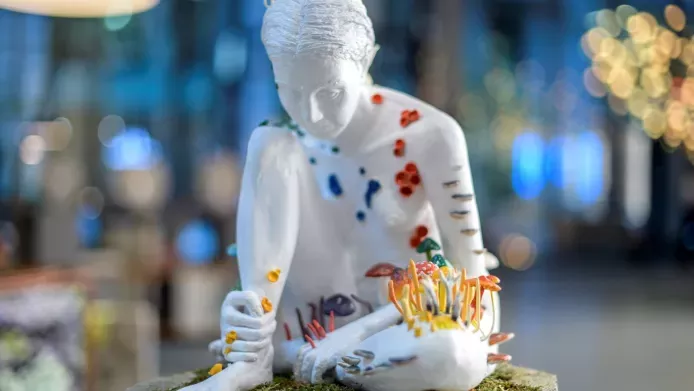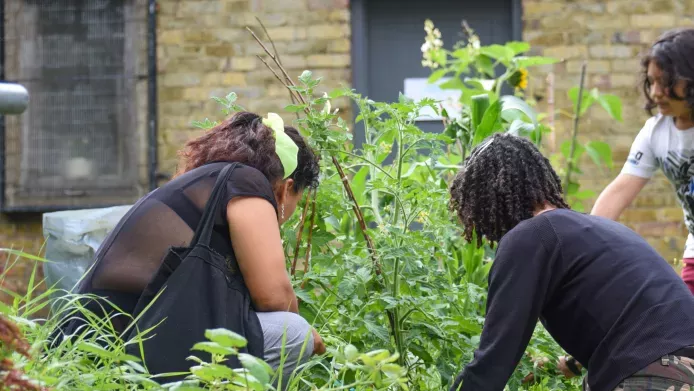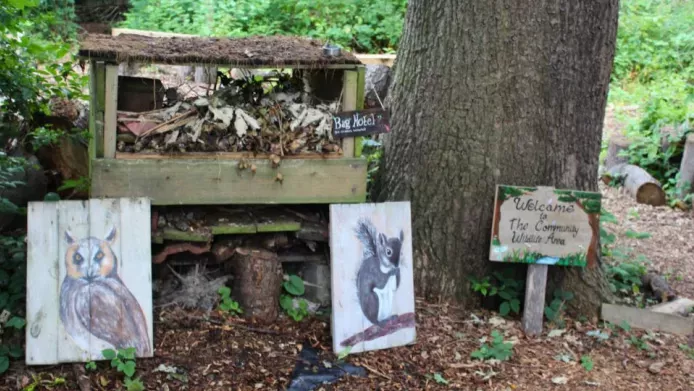Astor Secondary School is a specialist arts college in Dover. They applied to join the Grow Wild Community Programme to transform a concrete area next to their Special Educational Needs and Disability (SEND) offices into a multi-sensory garden space. We interviewed Gemma, the Occupational Therapist at Astor Secondary School who is overseeing their Grow Wild project.
Our school is in a concrete setting on a steep incline, so there is very limited outdoor space for our children to access. There was an abandoned paved area outside the Special Educational Needs Department (SEND), surrounded by some established trees and a grassy bank.
Students were constantly asking us if it was going to be anything and if we could have benches or a table there. We knew we wanted to do more with the area than that, to have space at school that they could call their own.
We sat down with our SEND students to gather their views on what they would find beneficial, and the students mentioned they wanted to start growing things, including their own tomatoes, and it started from there.
A lot of our students live in apartment blocks, so they don't have the luxury of a garden or outside space. Myself and other staff members wanted to support the students to discover skills like growing, the sensory benefits of gardening, as well as responsibility for the environment.

The students have been involved throughout the project, taking ownership of it and becoming young leaders. We're so grateful to be part of the Grow Wild programme because we would have found it difficult to do this otherwise; the work done so far has transformed the garden.
There's now colour, plants to smell, and plants the kids can eat. In the space there are big planters containing established plants, a bug hotel, and a greenhouse used for growing seedlings. We've also raked the grassy bank and scattered wildflower seeds there, so the space looks really welcoming now.
We've also raked the grassy bank and scattered wildflower seeds there, so the space looks really welcoming now.

During the summer holidays year six SEND students came in, as part of Astor’s summer school, and built a greenhouse in the garden. The students were so proud and have really enjoyed using the greenhouse, they light up when they’re holding a seed and staff say they can plant it. Another summer activity we did with the students was gathering materials to make bird distractors, which they used to protect seeds they had sown.
Lots of the school children visit the space during breaktimes, to sit, take a moment and eat their lunch. I have also noticed the positive impact from a behavioral point, students wouldn't dare litter in that area, because they're enjoying it too much.
We initially thought of the space transformation as a relatively small change, but it has had a massive impact on our students.
The garden is also used by the school’s Emotional Literacy Support Assistant as a space for student interventions. Sam, our Thrive practitioner, who is trained to work with children to promote positive mental health and emotional wellbeing, is heavily involved in the project. She built the planters with her students, and this autumn they have been planting spring bulbs.

We initially thought of the space transformation as a relatively small change, but it has had a massive impact on our students. The garden means a lot to the students already; they love it, even with just a few planters. The project can only get better from here and benefit the students even more. The students have requested more flowers and things they can smell; the next steps for the space are to include more plants providing a range of sensory experiences.
The garden covers a huge area, making the current planters look small. To make the area look full we’ve ordered two additional planters with trellises to support climbing plants. The school also has a student construction group, who are going to build further planters and benches from wooden pallets. In the future we hope to get parents involved because so many are builders or landscapers.

Our hope is to create a pond out of a donated truck tire using a solar powered pump, which is a simple and reliable way to provide a consistent water supply. A big concern is how we will protect wildlife in the pond from seagulls, as the school’s coastal buildings are annual nesting and berthing spots for gulls.
It's powerful taking the kids outside to a space without the associations they have of the classroom.
We want to integrate the space across learning areas such as reading intervention, History with medicinal plants, Performing Arts rehearsals, and the uses of plants for food and other benefits. It's powerful taking the kids outside to a space without the associations they have of the classroom. Although we want the space to be used by as many teachers as possible, we want the children to know it‘s their garden and treat it as such.
Astor’s student environmental committee has shared their desire to see more wildlife in the space. We have already noted that creatures such as garden birds, dragonflies, squirrels and possibly a fox have visited the garden.

More about Grow Wild's Community Programme

Previous projects


